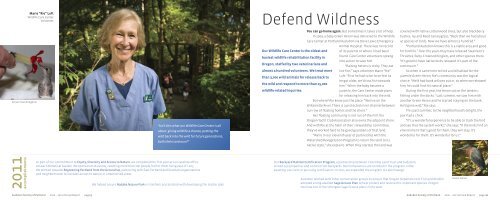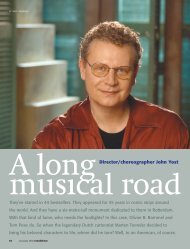Society of Portland
Audubon Society of Portland 2010 Annual Report - Nanci Tangeman
Audubon Society of Portland 2010 Annual Report - Nanci Tangeman
- No tags were found...
Create successful ePaper yourself
Turn your PDF publications into a flip-book with our unique Google optimized e-Paper software.
Marie “Rie” Luft<br />
Wildlife Care Center<br />
Volunteer<br />
Defend Wildness<br />
You can go home again. But sometimes it takes a lot <strong>of</strong> help.<br />
covered with native cottonwood trees, but also blackberry<br />
In 2009, a baby Green Heron was delivered to the Wildlife<br />
bushes, ivy and Reed Canarygrass. “Back then we had about<br />
Care Center at <strong>Portland</strong> Audubon via Dove Lewis Emergency<br />
40 species <strong>of</strong> birds. Now we have almost a hundred.”<br />
Our Wildlife Care Center is the oldest and<br />
Animal Hospital. There was no record<br />
<strong>of</strong> its parents or where it had been<br />
“<strong>Portland</strong> Audubon knows this is a viable area and good<br />
for bird life.” Over the years they have released Swainson’s<br />
busiest wildlife rehabilitation facility in<br />
Oregon, staffed by two veterinarians and<br />
almost a hundred volunteers. We treat more<br />
found. Care Center volunteers sprang<br />
into action to save him.<br />
“Raising herons is tricky. They eat<br />
live fish,” says volunteer Marie “Rie”<br />
Thrushes, Ruby-Crowned Kinglets, and other species there.<br />
“It’s good to have native birds released. It’s part <strong>of</strong> the<br />
continuum.”<br />
So when it came time to find a wild habitat for the<br />
than 3,000 wild animals for release back to<br />
the wild and respond to more than 15,000<br />
wildlife-related inquiries.<br />
Luft. “First he had to be force-fed. As<br />
he got older, we’d toss fish towards<br />
him.” When the baby became a<br />
juvenile, the Care Center made plans<br />
juvenile Green Heron, Rie’s community was the logical<br />
choice. “We’d had bank willows put in, so when we released<br />
him, he could find his natural place.”<br />
During the first year, the Heron sat on the tenders,<br />
for releasing him back into the wild.<br />
fishing under the docks. “Last summer, we saw him with<br />
Anna’s Hummingbird<br />
But where? Rie knew just the place. “We live on the<br />
Willamette River. There is a protected inner channel between<br />
another Green Heron and he started staying on the bank.<br />
He’d gone wild,” Rie says.<br />
our row <strong>of</strong> floating homes and the shore.”<br />
This past summer, to the neighborhood’s delight, the<br />
Her floating community is not run-<strong>of</strong>-the-mill: the<br />
pair had a chick.<br />
Oregon Yacht Club Association also owns the adjacent shore.<br />
“It’s a wonderful experience to be able to track the bird<br />
“Isn’t this what our Wildlife Care Center is all<br />
And with Rie at the helm <strong>of</strong> their stewardship committee,<br />
and see that the system works,” she says. “If the birds find an<br />
about: giving wildlife a chance, putting the<br />
wild back into the wild for future generations,<br />
both theirs and ours?”<br />
they’ve worked hard to be good guardians <strong>of</strong> that land.<br />
“We’re in our eleventh year <strong>of</strong> partnership with the<br />
Watershed Revegetation Program to return the land to its<br />
native state,” she explains. When they started, the land was<br />
environment that’s good for them, they will stay. It’s<br />
wonderful for them. It’s wonderful for us.”<br />
2011<br />
accomplishments<br />
As part <strong>of</strong> our commitment to Equity, Diversity and Access to Nature, we completed the first year at our satellite <strong>of</strong>fice<br />
at Leach Botanical Garden. We sponsored 26 events, reaching more than 200 people, half <strong>of</strong> them living east <strong>of</strong> I-205.<br />
We worked towards Regreening <strong>Portland</strong> from the Ground Up, partnering with East <strong>Portland</strong> and Gresham organizations<br />
and neighborhoods to increase access to nature in underserved areas.<br />
We helped secure Nadaka Nature Park in Gresham and assisted with developing the master plan.<br />
Our Backyard Habitat Certification Program, a partnership between Columbia Land Trust and Audubon,<br />
visited 250 properties and certified 100 backyards. 600 homeowners are enrolled in the program, either<br />
awaiting site visits or pursuing certification. In 2011, we expanded the program to Lake Oswego.<br />
Audubon worked with other conservation groups to ensure that Oregon Department <strong>of</strong> Fish and Wildlife<br />
adopted a long-awaited Sage Grouse Plan to help protect and restore this important species. Oregon<br />
now has one <strong>of</strong> the strongest Sage Grouse plans in the west.<br />
Green Heron<br />
Audubon <strong>Society</strong> <strong>of</strong> <strong>Portland</strong> 2010 – 2011 Annual Report page 9<br />
Audubon <strong>Society</strong> <strong>of</strong> <strong>Portland</strong> 2010 – 2011 Annual Report page 10



